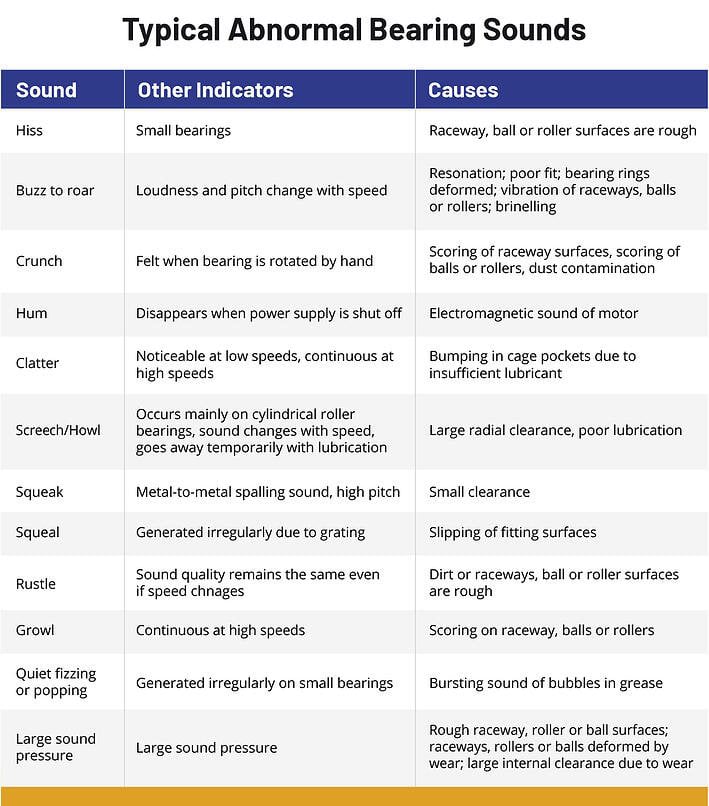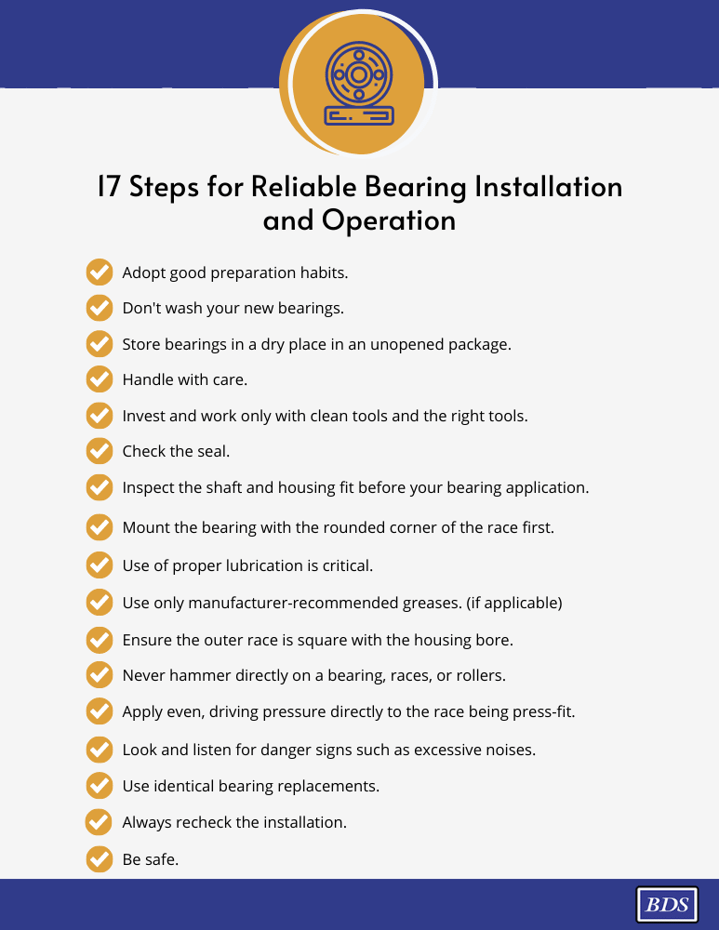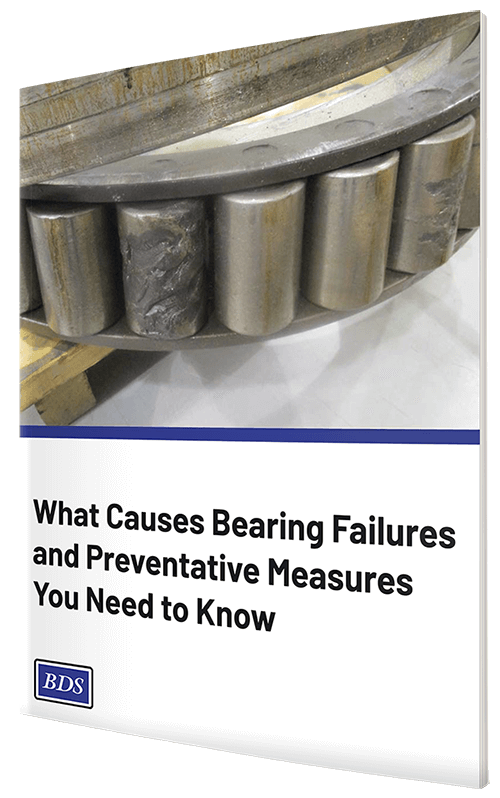When it comes to bearings, the quality of the performance you net begins with its installation quality.
This is a complete bearing installation checklist.
The best part?
Everything on this list will result in cost savings and prolonged bearing life as you install the bearings correctly the first time.
Did you know?
48% of bearings fail before their natural death from either being installed wrong or mishandled.
So if you prefer your bearings to be a part of the other 52% that doesn't prematurely fail, and you want them working in tip-top shape, you'll love today's checklist.
At Bearing & Drive Systems, we're committed to providing global sourcing network solutions that help you find the authentic bearing & PT products that your customers need now.
In the checklist, we have collected several industry tips from various sources about the value of correct bearing installation and strategies to increase your bearing operation reliability.
Let's get started.
- Step #1: Adopt good preparation habits.
- Step #2: Don't wash your new bearings.
- Step #3: Store bearings in a dry place in an unopened package.
- Step #4: Handle with care.
- Step #5: Invest and work only with clean tools and the right tools.
- Step #6: Check the seal.
- Step #7: Inspect the shaft and housing fit before your bearing application.
- Step #8: Mount the bearing with the rounded corner of the race first.
- Step #9: Use of proper lubrication is critical.
- Step #10: Use only manufacturer-recommended greases. (if applicable)
- Step #11: Ensure the outer race is square with the housing bore.
- Step #12: Never hammer directly on a bearing, races, or rollers.
- Step #13: Apply even, driving pressure directly to the race being press-fit.
- Step #14: Look and listen for danger signs such as excessive noises.
- Step #15: Use identical bearing replacements
- Step #16: Always recheck the installation
- Step #17: Be safe
Bearing Installation Guideline Checklist (Perfecting the Art and Skill)
Perfecting the art and skill of bearing installation will ultimately prolong its service life and minimize downtime caused by an unnecessary bearing failure.
When installing bearings, following procedures will reduce friction and ensure motion is regulated in the moving parts.
On a side note: Always consult with the original manufacturers directions first, as something special could have slightly different steps.
17 Steps for Reliable Bearing Installation and Operation
1. Adopt good preparation habits.
Keep bearings and surrounding area clean. Clean hands and clean surroundings help prevent the possibility of introducing harmful contaminants that can severely shorten the life of the bearing.
2. Don't wash your new bearings.
There is no need to wash bearings as manufacturers take precautions; they are free of dirt and other contaminants.
3. Store bearings in a dry place in their unopened package.
Leave bearings in the package until ready for assembly. Do not wash off the lubricant covering them. Bearing lubrication protects the surface from corrosion, sealing against contaminants.
Clean, dry, and vibration-free storage conditions are best.
4. Handle with care.
If a bearing is dropped on the floor, the best practice is not to install it.
The bearing must remain clean to prevent dirt or dust from damaging the bearing before and during use. A bearing should only be removed from its container or packaging when it's ready for installation.
5. Invest and work only with clean tools and the right tools.
"Induction heaters, oil injection kits, and hydraulic nuts are among the specialized tools available for mounting and dismounting bearings over 4 in. O.D. Their use lowers the possibility of damaging bearings and speeds the process." (source)
6. Check the seal.
Follow proper seal installation guidelines and use only recommended tools.
A seal installed next to the bearing is a way to prevent fine dirt, dust, moisture, and contaminants from reaching the bearing. A seal is a barrier designed to retain lubricants and exclude containments.
7. Inspect the shaft and housing fit before your bearing application.
The shaft seat and housing bore should be clean, smooth, with the correct dimensions. A proper shaft and housing fit are vital for the life of your bearings.
Bearings cannot operate properly if the shaft or housing is not in good condition. The housing must be cleaned before bearing installation.
Bonus - Steps for determining shaft fit
General applications include inner ring rotation and a constant radial load.
"For these conditions, we recommend an interference fit between the shaft and bearing bore. The level of interference will increase for heavier loads. When shaft conditions are stationary, and the radial load is constant, a moderate clearance fit between the shaft and the bearing bore is an option." (source)
Bonus- Steps for selecting the proper housing fit:
Considerations include:
- The rotation of the inner or outer rings
- Type of load
- And how easily it should be to install or remove the bearing from the housing.
Resource: Consider the bearing fit
8. Mount the bearing on the shaft with the rounded corner of the race first.
When mounting a bearing, the rounded corner of the bearing should be started in the shaft first.
9. Use of proper lubrication is critical.
Bearing manufacturers evaluate several factors before determining the type of lubricant required for specific bearings. Be sure to follow their recommendations. Temperature and contamination conditions will influence the frequency of lubrication changes.
Bearing lubrication is vital for preserving the performance and lifespan of rolling element bearings. Lubrication helps separate moving parts relative to one another, such as rollers and raceways or balls, to prevent wear and tear and friction. The lack of proper bearing lubrication is commonly regarded as one of the most prevalent bearing failure causes.
If you want to learn more about bearing lubrication, download our guide: "Bearing Lubrication Tips & Mistakes You Might Be Making."
Coating the bearing, housing, or shaft with the same lubricant used in the machinery will ease mounting and prevent rust from building up at the press-fit area.
10. Use only manufacturer-recommended greases. (if applicable)
While some bearing applications use oil as a lubricant, grease is the lubricant of choice for 80 to 90 percent of bearings.
General grease (NLGI #2) is the most common lubricant used in bearings. It is commonly used in motor applications.
Synthetic grease, used in aerospace applications, fits the parameters such as low torque requirements or low/high temperatures.
Grease lubrication features include reduced maintenance time, less leakage than oil, and confines itself to the housing or bearing.
11. Ensure the outer race is square with the housing bore.
Before any pressure is applied when installing, extra care should be taken. Premature bearing failure is often caused by misalignment.
12. Never hammer directly on a bearing, races, or rollers.
Direct blows from a hammer can cause the bearing to dent, crack, or fail.
Also, do not use a wooden or soft metal mallet, as chips or splinters may enter the bearing.
13. Apply even, driving pressure directly to the race being press-fit.
The level of force required to mount a bearing properly is determined by the type and degree of press-fit. Be sure that the pressure is straight and square.
Press-fits that are too tight can damage the bearing, causing excess heat and wear. Premature bearing failure can result when the press-fit race is installed too tight or too loose.
14. Look and listen for danger signs such as excessive noises.
Signs of improper bearing operation can result in excessive noises, increase in vibration, and temperature.

Source: Machinery Lubrication "5 Ways to Prevent Bearing Failures"
15. Use identical bearing replacements
Making sure that an exact replacement is used is essential.
"There are two ways to identify a mechanical component: taking measurements or checking for a part number. Reputable manufacturers mark the rings of a bearing with a part number." (source)
16. Always recheck the installation
Make sure the bearing is operating correctly for the application. Bearing adjustment recommendations do vary according to manufacturer and use. Refer to any service manuals or guidance from the manufacturer.
17. Be safe
For proper bearing installation to occur, all safety issues must be addressed. Stay safe and wear appropriate protective equipment where needed.
Here's your checklist to go...

Conclusion
Any questions?
We are always here to help. The correct bearing installation can save you time and increase the life of the bearing.
The key is using the right tools for mounting and the correct bearing manufacturing services to help you get the bearings you need.
We know it's stressful going outside of your typical supply chain to find the correct bearing for your customer, and ordering globally can be a daunting task.
Our global sourcing network at BDS enable you to get the bearing you need according to your order requirements without any hassle. Contact a bearings expert today.
Featured image: by StockSnap from Pixabay







